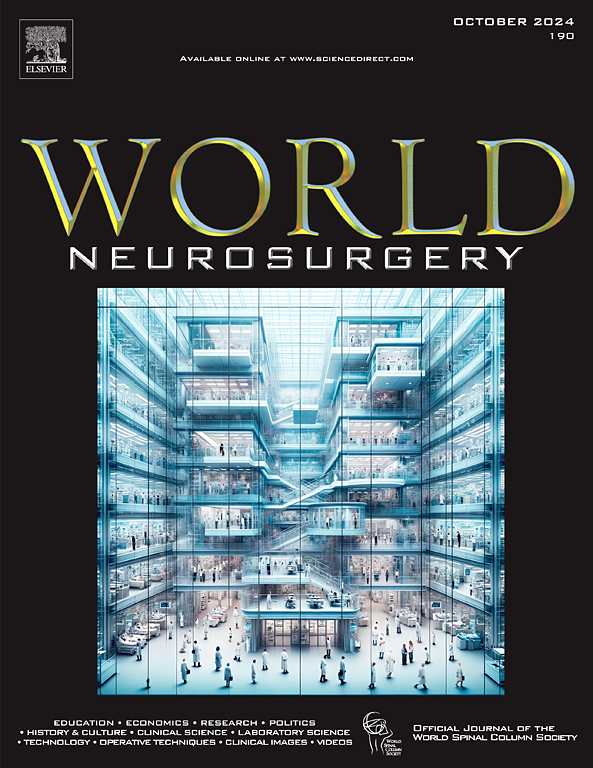Risk Score for Early Prediction of In-Hospital Mortality After Aneurysmal Subarachnoid Hemorrhage: Pooled Analysis With Score Construction and Validation
IF 1.9
4区 医学
Q3 CLINICAL NEUROLOGY
引用次数: 0
Abstract
Objective
Aneurysmal subarachnoid hemorrhage (aSAH) has a high complications burden, with in-hospital mortality as the most devastating outcome. We aimed to develop and validate a risk score for early prediction of in-hospital mortality after aSAH.
Methods
Data from 2 university hospitals were pooled (n = 1070), with cohorts for score construction (n = 886) and external validation (n = 184). Several parameters assessable at admission were collected. Independent predictors of in-hospital mortality were used as mortality score components. Diagnostic accuracy of the novel score was compared to the Hunt and Hess Age, Intraventricular Hemorrhage, Rebleed and World Federation of Neurosurgical Societies (WFNS) scores.
Results
Overall rate of in-hospital mortality was 19% and 14.7% in construction and validation cohorts, respectively. The novel risk score (aSAH mortality score: 0–12 points) included patients' age (≤55 years: 0 points, 56–70 years: 1 point, >70 years: 2 points), aneurysm rebleeding (2 points), WFNS grade (grade I–II: 0 points, grade III–IV: 2 points, grade V: 5 points), and Hijdra sum score (≤10: 0 points, 11–20: 1 point, 21–30: 2 points, >30: 3 points). In-hospital mortality rates ranged 0.6% (0 points) to 100% (12 points) in the construction cohort, and 0% (0 points) to 60% (10 points) in the validation cohort. In the receiver operating characteristic analysis, the aneurysmal subarachnoid hemorrhage mortality score (area under the curve [AUC]: 0.829 and 0.824 in the construction and validation cohorts, respectively) was superior to the Hunt and Hess Age, Intraventricular Hemorrhage, Rebleed (AUC: 0.811 and 0.813) and WFNS scores (AUC: 0.768 and 0.795).
Conclusions
Risk of in-hospital mortality after aSAH can be predicted with high accuracy using baseline characteristics. The novel risk score showed best diagnostic performance in the construction and validation cohorts and can aid in early prognostication and treatment decisions.
动脉瘤性蛛网膜下腔出血后院内死亡率早期预测的风险评分:评分构建和验证的汇总分析。
目的:动脉瘤性蛛网膜下腔出血(aSAH)具有很高的并发症负担,其中院内死亡是最具破坏性的结果。我们旨在开发并验证一种风险评分,用于早期预测蛛网膜下腔出血后的院内死亡率:方法:汇集两家大学医院的数据(1070 人),建立评分队列(886 人),并进行外部验证(184 人)。收集了入院时可评估的几个参数。院内死亡率的独立预测指标被用作死亡率评分的组成部分。将新评分的诊断准确性与 HAIR 和世界神经外科学会联合会(WFNS)的评分进行了比较:结果:在构建队列和验证队列中,院内总死亡率分别为 19% 和 14.7%。新的风险评分(aSAH死亡率评分[aSAMS]:0-12分)包括患者年龄(≤55岁:0分,56-70岁:1分,大于70岁:2分)、动脉瘤再出血(2分)、WFNS分级(I-II级:0分,III-IV级:2分,V级:5分)和Hijdra总分(≤10分:0分,11-20分:1分,21-30分:2分,大于30分:3分)。在构建队列中,院内死亡率为 0.6%(0 分)-100%(12 分);在验证队列中,院内死亡率为 0%(0 分)-60%(10 分)。在接受者操作特征分析中,aSAMS评分(在构建队列和验证队列中的AUC分别为0.829和0.824,下同)优于HAIR评分(AUC分别为0.811和0.813)和WFNS评分(AUC分别为0.768和0.795):结论:利用基线特征可高度准确地预测急性脑梗死后的院内死亡风险。新型风险评分在构建和验证队列中显示出最佳诊断性能,有助于早期预后和治疗决策。
本文章由计算机程序翻译,如有差异,请以英文原文为准。
求助全文
约1分钟内获得全文
求助全文
来源期刊

World neurosurgery
CLINICAL NEUROLOGY-SURGERY
CiteScore
3.90
自引率
15.00%
发文量
1765
审稿时长
47 days
期刊介绍:
World Neurosurgery has an open access mirror journal World Neurosurgery: X, sharing the same aims and scope, editorial team, submission system and rigorous peer review.
The journal''s mission is to:
-To provide a first-class international forum and a 2-way conduit for dialogue that is relevant to neurosurgeons and providers who care for neurosurgery patients. The categories of the exchanged information include clinical and basic science, as well as global information that provide social, political, educational, economic, cultural or societal insights and knowledge that are of significance and relevance to worldwide neurosurgery patient care.
-To act as a primary intellectual catalyst for the stimulation of creativity, the creation of new knowledge, and the enhancement of quality neurosurgical care worldwide.
-To provide a forum for communication that enriches the lives of all neurosurgeons and their colleagues; and, in so doing, enriches the lives of their patients.
Topics to be addressed in World Neurosurgery include: EDUCATION, ECONOMICS, RESEARCH, POLITICS, HISTORY, CULTURE, CLINICAL SCIENCE, LABORATORY SCIENCE, TECHNOLOGY, OPERATIVE TECHNIQUES, CLINICAL IMAGES, VIDEOS
 求助内容:
求助内容: 应助结果提醒方式:
应助结果提醒方式:


